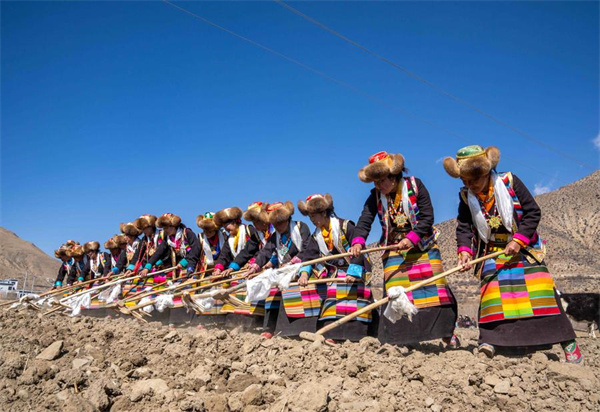Spring farming ceremonies embrace tradition, modernization in China's Xizang
Updated: 2024-03-18  Print
Print 



Farmers participate in a ceremony marking the start of spring farming in Gyaimain village in Qonggyai county of Shannan, Southwest China's Xizang autonomous region, March 16, 2024. [Xinhua/Tenzing Nima Qadhup]
LHASA -- On Saturday, annual spring farming ceremonies unfolded across agricultural areas of Southwest China's Xizang autonomous region, blending tradition with modern agricultural practices.
In Punsum Village of Qonggyai County, in the city of Shannan, the silence of the plateau fields was broken by roaring sounds of tractors. Nearly 30 of these vehicles stood in orderly formation as villagers presented the drivers with white hadas, traditional Tibetan silk scarves, symbolizing purity and auspiciousness.
Among them was Gyapel Tsering, a 56-year-old tractor driver clad in a conical yellow hat and a black woolen garment. At around 10 a.m., his tractor, adorned with a red tassel and bell reminiscent of those once decorating plowing yaks for millennia in Xizang, led the way into the fertile fields amid rising smoke from Tibetan incense.
"Our village's agricultural production has undergone full mechanization, significantly cutting down the time needed for plowing fields from over 10 days to just a few," said Gyapel Tsering, who acquired his tractor over a decade ago and oversees 12 mu (about 0.8 hectares) of crop fields.
Punsum Village boasts a population of 696 residents and over 1,300 mu of cultivated land, according to Dawa, the Party secretary of the village.
"We primarily cultivated high-quality varieties of highland barley," he said. "The yield per mu in our fields is approximately 300 kilograms, marking an increase of nearly 50 kilograms compared to previous years," he added.
With the widespread adoption of agricultural mechanization, the traditional plowing method, known as "two yaks lifting a yoke," has gradually faded into obscurity. However, in Gyaimain Village, situated approximately 10 km from Punsum, this ancient practice is still honored during the spring farming ceremony.
Wangdu, a 67-year-old villager, rose early on Saturday to prepare his plowing yaks for the ceremony. "The plowing ceremony is one of the most significant events of the year, attended by the entire village," he told Xinhua.
In a nearby field, 12 men, surrounded by over 100 villagers, sang traditional songs as they guided their yaks to plow the first furrow in 2024.
"Every spring, we continue to hold the ceremony to better preserve our agricultural culture of the plateau area," said Thubten, head of the village committee.
Qonggyai County aims to cultivate a grain area of 19,900 mu this year, primarily focusing on highland barley, according to the county's agriculture and rural affairs bureau.
Since the onset of spring, various townships and villages in the county have organized technical personnel to inspect and maintain agricultural machinery, as well as transport high-quality seeds, such as highland barley and wheat, to ensure smooth spring plowing.
Data from the regional agriculture and rural affairs department showed that Xizang had established 4.3 million mu of high-standard farmland as of Dec. 1 last year, with plans to add an additional 320,000 mu in 2024.
The grain output of the region has remained stable at over 1 million tonnes for nine consecutive years.








